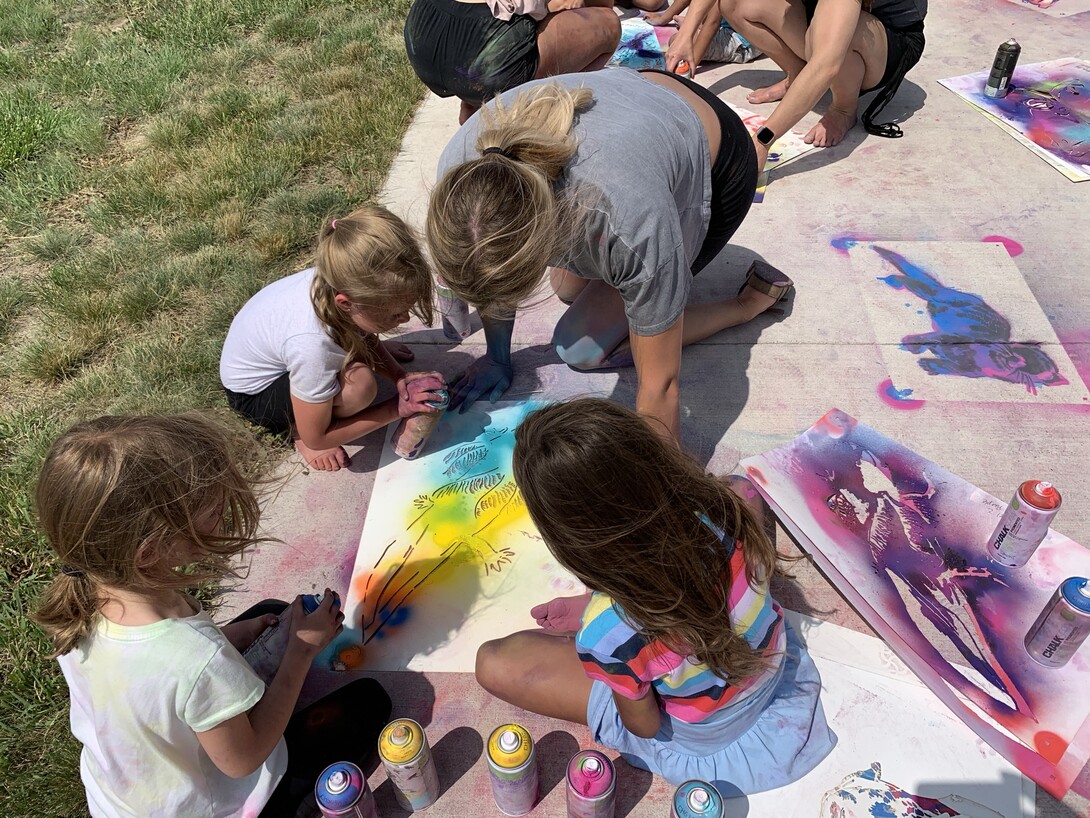
Sandra Williams spent a week in Alliance in June to collaborate on her community art project, “Stay Wild,” with the Carnegie Arts Center and the Alliance Recreation Center.
“Community-based arts have always been, and always will be, part of my creative agenda,” Williams, associate professor of art, said. “Instead of a ‘top-down’ lecture, I prefer that the community explore the role arts play in creative placemaking, have the tactile experience of handling cut paper in the form of stencils and engage with animals in a creative manner.”
It reunited her with Kyren (Conley) Gibson, a 2011 Husker graduate who is executive director of the Carnegie Arts Center in Alliance. While an undergraduate student at Nebraska, Gibson completed UCARE (Undergraduate Creative and Research Experiences) research with Williams and served as a teaching assistant for Williams’ Art in the Community course.
Gibson was eager to collaborate with Williams on the “Stay Wild” project.
“When Professor Williams reached out about collaborating on her project, the ‘Stay Wild’ sidewalk safari, I jumped at the opportunity to work with my mentor once again,” Gibson said. “I think it is incredible that we have a UNL art professor that is willing to travel six hours across state to contribute not only to the beautification of our community, but to the educational development of youth in a rural community.”
Williams was assisted by two School of Art, Art History and Design students, who were part of the Husker Afterschool Learning Opportunities program, to work with the Alliance Recreation Center’s students. HALO gives students the opportunity to assist with youth programming at local community sites over the course of the summer by leading clubs.
Gibson said both Williams and the Carnegie Arts Center believe in the importance of meaningful arts experiences for underserved populations, so they worked with the Alliance Recreation Center on the project. Their afterschool program and summer camp serve an average of 40% low-income youth annually.
“Art programs allow our students to express themselves in a healthy, positive way,” said Courtney Hardin, the program director for the Alliance Recreation Center. “The excitement our kiddos had at being allowed to use spray chalk stands out to me. The messier the project, the more excited our kids get. They aren’t always given those types of experiences at school or home.”
Williams designed seven stencil sets of endangered animals, including a tiger, tree frog, axolotl, black-footed ferret, panda, big horn sheep and rock hopper penguin. Each stencil set included three layers with different levels of detail to create depth and contrast in the images. Six sets were created for each animal.
The 60 students from the Alliance Recreation Center were broken into classes of 15. Students worked in teams and took turns selecting their colors and spray chalking the stencil layer while their teammates helped hold down the stencils.
“Each finished stencil set was a collaborative masterpiece,” Gibson said. “It was essential to Professor Williams’ process that the children were able to take ownership in the process by selecting the animals they wanted and the color combinations. The results were unexpected and stunning.”
After two days of spray chalking and stenciling, the students were given fact sheets about the different endangered species. The older youth created haikus about the animals, and younger students created drawings of the animals and recited facts they had learned.
Mara Anderson, the executive director of the Alliance Recreation Center, was thankful for the collaboration.
“Watching the kids have fun is always rewarding, but seeing the magic that Carnegie Arts Center and the University of Nebraska–Lincoln staff and students shared with our summer camp was truly something spectacular,” Anderson said. “The kids had a great time, and they were so excited every day that week for all the art projects.”
Gibson said students learned a lot from the project.
“These kids not only were educated about endangered species, but how art can be a tool to generate awareness about these animals and their role in being conservators of the world,” she said. “As a natural element of the artistic process, they engaged in team building, leadership, collaboration and ownership in the beautification of their public spaces.”
Williams worked with students at Park Middle School in Lincoln in 2020 to create the “Stay Wild” community art project in Lincoln, after initially developing it in partnership with the Museum of Nebraska Art in Kearney. Williams also plans to bring the project to Las Vegas in 2022 when her exhibition, “Anthropocene Blues: Nature and the Social Imagination,” will be on display at the Marjorie Barrick Museum of Art.







